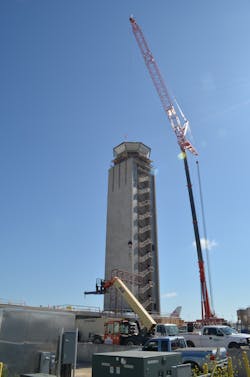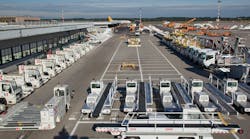The Chicago Department of Aviation’s (CDA) ongoing O’Hare Modernization Program (OMP), which is anticipated to be completed in 2021, has already achieved many major milestones, including the recent opening of the $516 million, 7,500-foot-long Runway 10R-28L and the new $41 million, 218-foot-tall south air traffic control tower. Initiated in June 2001, the more than $8 billion OMP is transforming O’Hare’s airfield from an intersecting runway system to a more efficient parallel runway system — increasing the airport’s capacity, reducing delays and meeting the anticipated demand well into the future.
Runway 10R-28L adds another parallel east-west runway for the south airfield in alignment with the predominant wind direction in Chicago. O’Hare’s fourth new east-west runway in the last 10 years, it has significantly increased the arrival/departure rate under visual flight rules (VFR) conditions. The runway enables planes to operate safely at high capacities in all weather conditions. The new south tower is the second new tower at O’Hare to be designed to achieve LEED certification. The commissioning of Runway 10R-28L and the south air traffic control tower marked the completion of all runway/taxiway construction in the south airfield for the OMP.
WSP | Parsons Brinckerhoff has served the city of Chicago for more than 10 years, managing the construction of four runway components and two air traffic control towers as part of the OMP. The firm is responsible for construction management, inspection, quality assurance, safety, project controls, document control and contract administration.
Designed for Sustainability
O’Hare operated with one control tower until November 2008, when a second tower, the north air traffic control tower, was commissioned. The opening of the new south tower in October gives O’Hare three Federal Aviation Administration (FAA) certified towers.
The newest towers were constructed with sustainability in mind from design through construction. The north tower was the first certified LEED® Silver air traffic control tower in the U.S.; LEED Gold certification is being pursued for the south tower.
Innovations not previously seen in air traffic control towers were incorporated into both towers. They each have green roofs on the base buildings and include sustainable components, such as high-efficiency systems and use of recyclable, local and low-emitting materials. Additionally, the south tower operates with a geothermal system of heating and cooling, LED lighting wherever possible, and a high-performance curtain wall designed to maximize the use of daylight.
Moreover, nearly all of the construction material stayed on site instead of being hauled away, and it was reused wherever possible. Recycling measures were extended to the runway projects as well, where concrete was crushed into aggregate and reused whenever possible in the runway and taxiway shoulders.
Collaboration Is Key
Collaboration is critically important for the successful execution of the largest airport construction program in the U.S. Much of the firm’s personnel has been involved from the start of the program, working in the same building as the OMP team. The co-location of the construction manager with the program manager, designers, airline representatives, and the CDA has enabled the prompt discussion and resolution of construction issues. In addition, the team’s weekly meetings with airport stakeholders have been critical to the success of these projects, ensuring that any planned closures of taxiways and runways will have little or no impact on airport operations.
There were major work challenges involved in the construction of Runway 10R-28L, which is located on an active airfield. This involved moving 3.5 million cubic yards of soil despite an extraordinary rainfall in the spring of 2014. Two tunnels were constructed under the runway and taxiway through the winter of 2014-15 — a harsh winter even by Chicago standards — to maintain the schedule. The contractor was tasked with providing winter protection and temporary heating to allow concrete to be poured throughout the season.
Although the majority of Runway 10R-28L is outside of most taxiways, the fiber optics transmission system (FOTS) loops had to be pulled throughout the airfield. The work was carried out at night to minimize the impact on airport operations. On previous runway projects, runway thresholds were displaced to enable construction in the safety areas. The associated reductions in runway lengths restricted the weight limits of some aircraft; however, the runways safely remained in operation during construction.
Transforming O’Hare
Several components remain to complete the OMP: construction of Runway 9C-27C, a crossfield taxiway system, a deicing pad/facility and the relocation of Taxiways A and B. With the completion of the OMP, O’Hare will have a total of eight runways — six east-west parallel runways and two crosswind runways.
To date, the Runway 10R-28L project has received the American Council of Engineering Companies of Illinois’ 2014 Honor Award and the Hispanic American Construction Industry Association’s 2015 Project of the Year Award.
As the nation’s largest airport construction program, the OMP continues to serve as a model for how to execute such a massive program on schedule, under budget and in the most sustainable manner possible. Moreover, as a catalyst for economic growth and job creation, the CDA’s OMP is making a significant contribution to keeping O’Hare and the City of Chicago competitive in the global marketplace.
Thomas C. Lyon, P.E., Construction Manager, is overseeing the work on the OMP in Chicago for WSP | Parsons Brinckerhoff.




